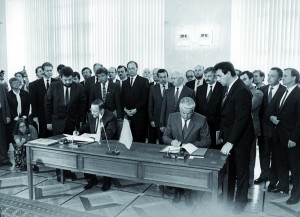
Moscow, 1991
Modern history of Lithuanian-Russian relations starts in 1991 when Vytautas Landsbergis and Boris Jelcin signed an international agreement on July 29th. Lithuanian orientation towards NATO and EU made it difficult to find alligned interests with autocratic leaders in the East. With Vladimir Putin entry to the Kremlin leader position tension between our states was constantly increasing.
Despite intense commercial trade high-level political contacts were extremely rare after Lithuanian entry to the EU and NATO in 2004. It seems, that there were no high-level meetings during 6 years up to 2010.
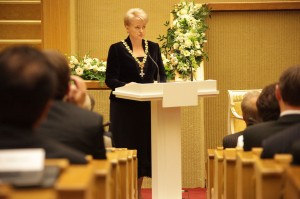
Vilnius, 2009 July 12
Russian media made a point after the newly elected President Dalia Grybauskaite made a direct phone call to Russian President in August 2009.
Сам факт, что Грибаускайте проявила инициативу и попросила телефонного разговора с президентом России настроил его на дружелюбный тон. Он пообещал решить вопрос в положительном ключе. Мы видим, что ее менталитет сформирован по-другому и ведет она себя по-другому. И впервые за последние годы происходит разговор в каком-то человеческом тоне между президентами России и Литвы.
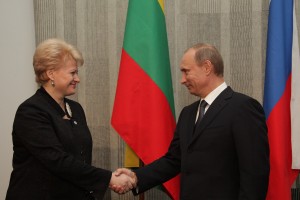
Helsinki, 2010
Things seemed doomed to change:
- in September 2009 she welcomed Aliaksandr Lukasenka in Vilnius
- in March 2010 she met Vladimir Putin in Helsinki
- in April 2010 she refused Obama’s invitation to meet him as a member of pack of Eastern European leaders in Prague
While playing games with Eastern leaders Dalia Grybauskaite supported right-wing coalition and its Government in Lithuania, where several strategic goals in energy sector were evident: (a) new nuclear plant; (b) LNG terminal; (c) structural reform of gas monopoly in Lithuania. All of them were certain measures against Russian influence. And Kremlin understood it perfectly.
Economic Pressure
So called “open doors for a change in the dialogue” were not supported with long-term changes in lower bureocracy. Russia kept pressing major Lithuanian interests:
- May 2009 – plans to build a new nuclear plant in Kaliningrad region (as a response to Lithuanian preparations)
- August 2009 – extra border checking for Lithuanian tranport companies
- September 2009 – investigation in Lithuanian milk export
- December 2009 – pre-Christmas season ruined for Lithuanian transport companies
- 2011-2012 peek prices for Russian gas imports
- 2012 – pushing referendum against new nuclear plant agenda
- September 2013 – extra checking procedure for Lithuanian transport companies
- October 2013 – milk production refused certificates
- April 2014 – meat production export forbidden
Russian information warfare
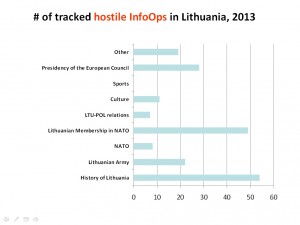
source: Ministry of Defense
In October 2014 representatives of Lithuanian Ministry of Defense publicly presented data, which label and identify Russian information warfare (Information Operation under NATO classification, InfoOps).
It is clear, that Russian InfoOps made regular attempts to disseminate specific information, related to strategic Lithuanian goals – membership in NATO and EU, national identity and trust with our armed forces.
In essence it is nothing new. State Security Department regularly publishes public reports, where various levels of Russian activity is documented on Lithuanian soil. For example:
- June 2012
[..] In 2011 information campaigns were carried out against Lithuania, they receive regularly growing funding.
- June 2013
[..] An active information, ideological and history “rewriting” policy is executed against Lithuania.
- March 2014
[..] Hostile Russian information and ideological policy is executed by administration of the President of Russian Federation, Government, state and state-sponsored information and spy agencies, media, academia, “non-governmental” organizations, security agencies, particular journalists, polititians, historians and PR specialists.

source: Ministry of Defense
Meanwhile Lithuanian MoD identifies ten major hostile InfoOps targets in Lithuania.
Active phase of Russian InfoOps: several examples
Some researchers (e.g. Aleksandras Matonis) state, that modern Russian InfoOps in Lithuania should be dated back to September 2005, when a solid media campaign was carried out after Russian Su-27 crashed near Jurbarkas. The incident was used to provide clear evidence, that Lithuania had no means to protect our air space and NATO support was weeks if not months ahead past similar event.
As presented above, MoD data from 2013 clearly shows, that Russian activity was directly related to Lithuanian Presidency of European Council. It should have ended with Ukraine signing Association Agreement in Vilnius (planned for 29th November, 2013), but Yanukovych refusal and following Maidan revolution turned everything upside down.
Russian propaganda went into heated public discussion after October 4th, 2013, when Kremlin-owned TV channel Первый Балтийский Канал aired program Человек и закон, which presented fake version about tragic Vilnius events of January 13th, 1991. Following official investigation program broadcast was temporarily banned by the court order.
Kremlin moved confrontation to the TOP level on March 4th, 2014, when Vladimir Putin publicly condemned Lithuania with training of Ukraine independence fighters, which was an open lie:
В.ПУТИН: [..] посмотрите, как хорошо были подготовлены люди, которые орудовали в Киеве. Их, как известно, готовили на соответствующих базах на сопредельных территориях: в Литве, Польше, и в самой Украине тоже. Готовили инструкторы, готовили в течение длительного времени. Они уже разбиты на десятки, на сотни, действуют организованно, с хорошими системами связи.
Lithuanian response
Although public discussion about ongoing Russian propaganda efforts started in mid-2013, it was only 2014 and Putin’s statement, what triggered response from TOP Lithuanian officials:
- March 4th, 2014 – public denial by Lithuanian MoD
- March 17th, 2014 – State Security Department – Report on Threats to National Security
- March-April, 2014 – public service media channels – pan-Baltic cooperation on creation of special TV channel, oriented towards Russian ethnic minorities – idea was canceled in August, 2014
- March-May, 2014 – Radio and TV Commission – decision to temporarily shut-down “NTV Mir Lithuania” channel broadcast license in Lithuania (after “PBK Lihtuania” similar program as in October 2013) – court approved sanctions were in force May-August 2014
- June 2014 – Government – proposed Law on Cyber Security is still waiting for the final reading in the Parliament
- July 4th, 2014 – Minister of Culture – working group on legal regulation of propaganda and sanctions against it – no results as today
- September 2014, President – amendments to the Law on Dissemination of Public Information – refused by the Parliament on Ist reading
- September 4th, 2014 – State Security Department – Announcement on Threats to Information Security of Lithuania
- September 19th, 2014 – State Security Department – How-To identify foreign agents and their activities, best practices to respond
At the same time it is important to state, that there were no coordinated Lithuanian response – it was based on ad hoc ideas, executed by particular leaders without any cooperation. Moreover, there were no effective response at all from MoD, Ministry of Interior, MoFA, State Security Department, Lithuanian Army or Communications Regulatory Authority.
NATO background
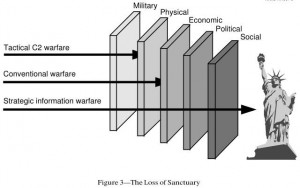 Information Warfare is nothing new to global conflicts. Propaganda techniques were widely used both by Nazi and Soviet armies even in WWII. All these were in rapid development and wide field testing in basicly every major military conflict. Modern platform of strategic position of Information Warfare is concisely presented in this figure, published by the National Defense Research Institute in 1996. Infowar targets core principles and values of our society, which is evident with Kremlin actions in Ukraine. Russian Federation aims to weaken economic and political support, build resistance towards pro-independence position inside the society.
Information Warfare is nothing new to global conflicts. Propaganda techniques were widely used both by Nazi and Soviet armies even in WWII. All these were in rapid development and wide field testing in basicly every major military conflict. Modern platform of strategic position of Information Warfare is concisely presented in this figure, published by the National Defense Research Institute in 1996. Infowar targets core principles and values of our society, which is evident with Kremlin actions in Ukraine. Russian Federation aims to weaken economic and political support, build resistance towards pro-independence position inside the society.
On tactical level information warfare according to NATO doctrines should be analyzed according to several major fields:
- Information Operation (InfoOps)

Info Ops doctrine
Considerations relevant to the conduct of operations, such as the sensitivity to political factors, and the role of non-military entities and emerging technological capabilities in the information environment, both within and external to NATO. Info Ops is a military function to provide advice and coordination of military information activities in order to create desired effects on the will, understanding and capability of adversaries, potential adversaries and other NAC approved parties in support of Alliance mission objectives.
- Psychological Operations (PsyOps)
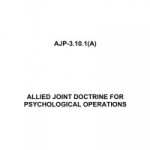
Psy Ops doctrine
Planned psychological activities using methods of communications and other means directed to approved audiences in order to influence perceptions, attitudes and behaviour, affecting the achievement of political and military objectives.
Other related areas are: electronic warfare (EW), computer network operations (CNO), military deception (MILDEC), operations security (OPSEC), military information support operations (MISO) and so on.
On 1st July, 2014 7 NATO members (Latvia, Estonia, Germany, Italy Lithuania, Poland and the UK) established the NATO StratCom Centre of Excellence in Riga. Its aim is to focus on providing an alternative to the official Russian narrative on the crisis in Ukraine. Hopefully, it will strengthen up NATO competence to counter Russian Information Warfare techniques.
Corporate best-practice

24/7 center
As early as 2010 such companies as Gatorade and Dell tried to establish 24/7 media monitoring centers, which monitor various media channels and lead response teams in case of troubled situations.
On NGO side American Red Cross initiative to establish a Digital Operations Center provides a perfect example, how digital technologies can be employed in order to create automated and issue-triggered approach towards identified both internal and external threats or hostile actors.
Similar monitoring potential is essential for our countries to be ready to counter Russian propaganda and defend our values. As today there is no information about similar NATO projects even in development phase.
Lithuanian Response: in Theory vs. in Practice
MoD does have a vision to counter hostile propaganda:
- tracking (monitoring)

Countering hostile propaganda
- explaining
- informing (answering)
- seeking support
- building patriotism
- preventing
- destroy hostile presence
- “no” to propaganda
- stop/hide hostile content
- proactive education
But in practice Lithuanian confrontation against Kremlin’s information warfare was:
- too slow
RU activities started as early as Q4 2013 with no LT response as long as March 2014
- without coordination, leadership & dedicated response team
Who is in charge? What is our response budget? What are triggers and potential boundaries?
- without consistent response legend(s)
Too much improvisation on ad hoc base for all major RU targets: why, against whom, how
- without relevant counter-measure(s)
E.g. low-efficient legal regulation measures vs. content dissemination via social networks and target audience outreach via alternative channels
P.S. This text is based on a presentation, delivered in Baltic PR Awards 2014 conference on November 15th, 2014 in Riga.
P.P.S. The position expressed in this text is personal evaluation compiled from public sources and has no any relations to Lithuanian authorities.
 n PR industry, especially during communication audit, when situation SWOT is being produced. Skeleton might be a real yet undisclosed weakness or potentially dangerous outcome (threat) of some major forces. In both ways the information would start the process, which could evolve into a substantial crisis situation.
n PR industry, especially during communication audit, when situation SWOT is being produced. Skeleton might be a real yet undisclosed weakness or potentially dangerous outcome (threat) of some major forces. In both ways the information would start the process, which could evolve into a substantial crisis situation.









